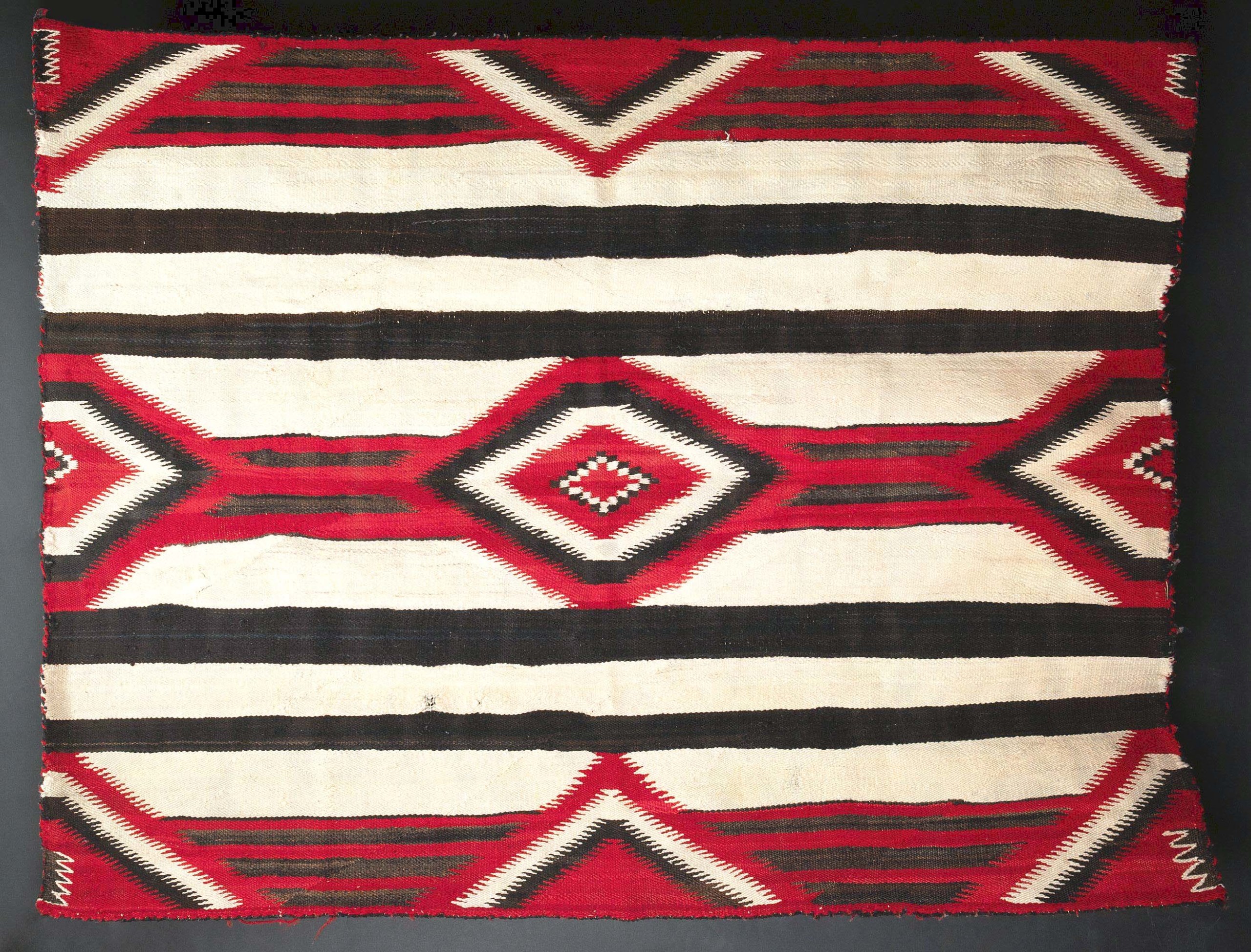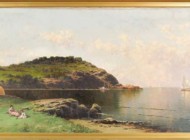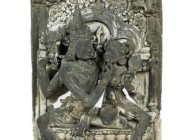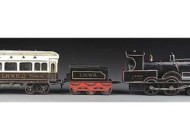
Relating to his “The Quiver Maker,” this oil on board by Eanger Irving Couse (1866-1936), early Twentieth Century, 14¼ by 16¼ inches framed, was recently discovered in a local family collection and sold to another Kansas buyer in the room for the sale’s top price of $58,080 ($20/30,000).
Review by Carly Timpson
LONE JACK, MO. — Soulis Auctions’ September 28 Fall Art Auction featured 307 lots ranging from abstraction to realism across various mediums, including oil paintings, prints, bronze sculptures and Native American art objects with abstract designs that long predate Modernism. Owner Dirk Soulis shared that the assortment of works in the auction contributed to the strong participation and results. “I had a nice collection of Native American things — not enough for an entire sale, but I thought they dovetailed pretty well with this grouping, so I played around with the idea that they were the first abstractionists in America. We had an Edmund Lewandowski displayed in the gallery next to a parfleche case made by an anonymous woman, and the contrast between them was really neat. The theme was kind of abstract art from the late Nineteenth Century, which is sort of an oxymoron, but it worked with certain parallels being drawn between seemingly different pieces.” In total, with 57 in-person and phone bidders as well as a few thousand online, the auction realized $554,000.
Leading the charge at $58,080 was a work that stitched both of Soulis’ threads together: a newly discovered oil painting by Eanger Irving Couse of a young Native American man. Done in the early Twentieth Century, this work related to others by Couse, including “The Quiver Maker,” which similarly showed a man by fire, working with a hide quiver and with Native pottery beside him. Soulis added, “We’re fortunate to get some really fresh and noteworthy pieces, like the previously unrecorded or unknown work by E.I. Couse, ‘The Quiver Maker.’ It wasn’t an uncommon theme, but that particular work was unknown. It was in one family for about 50 years, and we were able to be sure everything was correct with it and it will be entered into the Couse catalogue raisonné. We had a lot of people register in advance for this piece and it sold to a fairly local man in the room who has bid with us before.”

“Woman from Dachau” by Walter Ufer (New Mexico, 1876-1936), 1912, 25 by 22 inches framed, earned $18,150 ($15/20,000).
Other artists, like Couse, who were affiliated with Taos or Santa Fe, N.M., also saw strong bidding. “When it comes to artists associated with Santa Fe or Taos, it doesn’t get much better than Walter Ufer or William Penhallow Henderson. The two works we had by them were earlier, not necessarily associated with those schools or colonies, but it was really neat to see these early works perform well. It was really interesting in terms of subject matter and maturity of them as artists,” shared Soulis.
Ufer’s 1912 “Woman from Dachau,” painted in the artist’s colony near that city, showed a Bavarian peasant woman and it was exhibited and published several times in the first half of the Twentieth Century. According to Soulis, “Ufer’s instructor in the German art colony, Walther Thor, was a very gruff man. Ufer painted the portrait of this woman in festive clothing, and when he showed it to Thor, the man took a palette knife and wiped it clean, telling him to do it again. When he repainted the portrait, the instructor said, ‘Good, I wanted to make sure the first time wasn’t an accident.” A testament to the work’s desirability after multiple publications listed it as “whereabouts unknown” and this being the first time it was offered for sale since the early Twentieth Century, the “Woman from Dachau” sold to an online buyer in Michigan for $18,150.
Henderson’s untitled oil on canvas of a white woman in a Japonisme-inspired gown was also a significant difference from his later, more celebrated Southwestern works. The catalog noted that “before his move West in 1916, his work reflected the cosmopolitan influences of Boston and Europe, where he was exposed to trends like Japonisme. This early painting, with its flattened composition, stylized birds and foliage and focus on ornamental surface, displays that decorative sensibility.” Ultimately, the work sold over the phone to a buyer in Nashville for $15,730, just exceeding its high estimate.

This Untitled (Oriental Fantasy) oil on canvas by William Penhallow Henderson (1877-1943), circa 1915, 44½ by 55½ inches framed, sold over the phone for $15,730 ($10/15,000).
The Michigan-based buyer of the Ufer painting also went home with two other notable works: William Samuel Schwartz’s “Late Afternoon” and “Witches in Britches” by Dorothy Bartholemy. “Late Afternoon,” painted circa 1935, was a “quintessential American scene” exhibiting the values of the WPA era, showing laborers in the fields under dramatic skies. This piece was bid past its $20,000 high estimate to achieve $22,990. Bartholemy’s “Witches in Britches,” according to Soulis, “was a commentary on women wearing trousers. Six years before it was painted, a woman had been arrested for wearing pants in a Texas courtroom. WWII changed all that with Rosie the Riveter and the necessity that women worked. From there, there was no going back. It was a fun one to work with and look into; interestingly, Merriam-Webster defines a ‘witch’ with several meanings, including ‘a woman believed to possess supernatural powers, often harmful, and to practice sorcery or enchantment.’” Bartholemy’s painting shows the determination of these “witchy women” to remain rebellious and continue wearing pants even after the war. The buyer took the ladies home for $2,662.
A notable aquatint by Henry Moore depicting the artist’s “Stone Reclining Figure” sold to a private collector in New York City for $31,460, just exceeding its $30,000 high estimate. The etching, aquatint and drypoint was printed, by 2RC Edizioni d’Arte (Rome), in deeply saturated black ink on Magnani paper, signed and dated “1980” and was published by the Raymond Spencer Company for the Henry Moore Foundation. Soulis reported that the work also “saw bidding on phones from London and elsewhere, but it went to an internet bidder.” The same buyer also won, for $7,260, an untitled Cubist work from the mid Twentieth Century by Alexander Corazzo.

Bidding for this etching, aquatint and drypoint “Stone Reclining Figure” on Magnani paper by Henry Moore (1898-1986), 1980, 51¼ by 96½ inches framed, rested at $31,460 ($20/30,000).
Other abstractions included Edmund D. Lewandowski’s “Christmas Tree,” which was exhibited in 1961 at the Metropolitan Museum of Art (New York City), the Chicago Art Institute’s 60th Annual Exhibition of American Art and the Museum of Modern Art (New York City), as well as being illustrated in the October 1950 edition of Art Digest and Abstract Painting and Sculpture in America by Andrew Carduff Ritchie (1951). This “Christmas Tree,” rather than having spindly branches, was an industrial configuration that would control the flow of gas or oil from a well. Widely exhibited yet never sold at auction, the work made an impression on bidders and rose to $19,360, selling to a Los Angeles buyer.
“Haystacks,” alternately titled “West of Lindsborg,” by Birger Sandzen was the sale’s leading landscape, selling to an online buyer in Houston for $31,460. Painted in oil on Masonite in 1952, the idyllic scene showed pre-mechanized haystack in Kansas. An inscription on the back of the work read, “Gallery / Not for sale,” which matches details from the Sandzen card catalog; however the auction catalog noted that many of these “keepers” were later sold or given away. Additionally, there’s a note that indicates, “Throughout 2025, Soulis Auctions will donate a portion of proceeds from the sale of all works by Birger Sandzen and the Prairie Print Makers, including this painting, to the Birger Sandzen Memorial Gallery’s expansion project, Building for the Future.”
Soulis’s next auction will be a benefit for the Birger Sandzen Memorial Gallery in Lindsborg, Kan., on November 8 at Unity Temple on the Country Club Plaza in Kansas City.
Prices quoted include the buyer’s premium as reported by the auction house. For information, www.soulisauctions.com or 816-697-3830.












